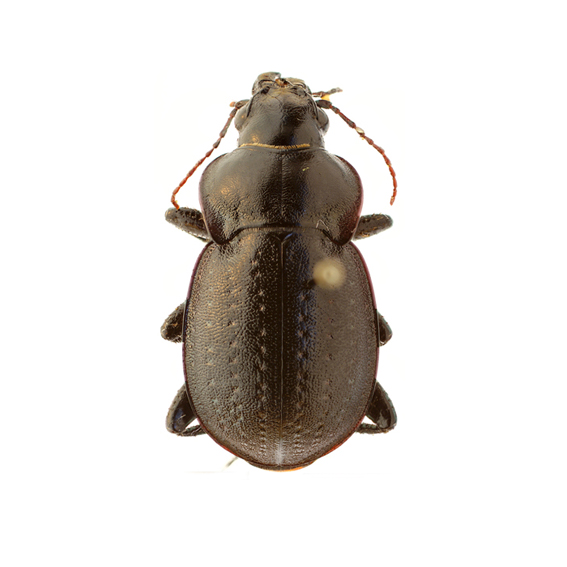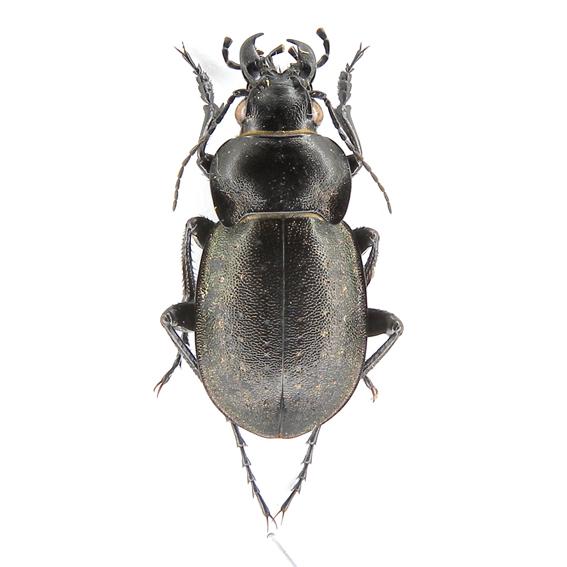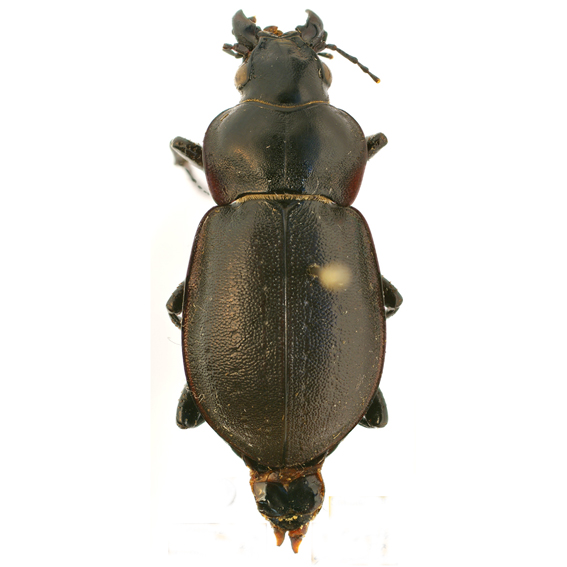Calosoma (Callisthenes) anthrax Semenov, 1900
C. anthrax, represents the the easternmost species of Callisthenes. It is characterized by the pronotum with sharply protruding posterior lobes, by a rather squat shape and dark bronze color.
It is located in eastern Mongolia and in northern China.
Calosoma (Callisthenes) anthrax anthrax Semenov, 1900
Calosoma anthrax Semenov, 1900: 304 (type locality: near Buir nur toward south), holotype ♂ in Zoological Museum of the Russian Academy of Sciences, Saint Petersburg (Obydov, 2002: 91)
Calosoma (Callisthenes) anthrax Breuning, 1928: 73
Callisthenes anthrax Lapouge, 1932: 376
Callisthenes anthrax Jeannel, 1940: 191
Length 21,5-25,5 mm. C. anthrax anthrax is characterized by transverse pronotum with conspicuously protruding posterior lobes. The sculpture of elytra consists of widespread raised graininess in which the foveae corresponding to the primary intervals are well evident. The color of the upper body is very dark with weak bronzed reflexes.
It has been described from the Mongolia's eastern border with China and later found in various localities of Northern China (Inner Mongolia, Gansu and Shanxi).
Examined specimens and literature’s data
China. Gansu: Xiahe (Deuve, 1997: 57); Inner Mongolia: Hulun nuur (Dalai-nor) (Obidov, 2002: 91), Xilinhot (AC, SB), Jining (Deuve, 1997: 57), Wuchuan (SB); Shanxi: Datong (GP).
Mongolia. Cojbalsan aimag: Khalkhyngol sum (Mandl, 1966: 286), 230km E SW of Choibalsan (Cojbalsan) (Obidov, 2002: 91), south of Buir nur (Bujr nuur) (type, Obidov, 2002: 91)
Notes: Brachypterous. Adults were collected from mid May to August.
 Semenov, 1900 Khing. south of Buir-Nur lake, 19.VI.1899, exp. Potanin (Zoological Institute, Russian Academy of Sciences, St. Petersburg) (holotype) (photo Anichtchenko A. 2010) |
 Semenov, 1900 Chine: Shanxi, 25 km north of Datong, VII.2007, (coll. Pontuale). |
Calosoma (Callisthenes) anthrax grumi Semenov, 1900
Calosoma Grumi Semenov, 1900: 306 (type locality: near Danger-tin, east of Kuku-nor), holotype ♀ in Zoological Museum of the Russian Academy of Sciences, Saint Petersburg (Obydov, 2002: 91)
Calosoma (Callisthenes) grumi Breuning, 1928: 74
Callisthenes anthrax grumi Lapouge, 1932: 376
Callisthenes grumi Jeannel, 1940: 191
Calosoma (Callisthenes) anthrax grumi Deuve 1997: 57
Length 22,5 mm. C. grumi was described by Semenov in 1900 on a single female specimen from East of Kuku-nor in northern China (Qinghai). It slightly differs from C. anthrax because of the less developed lobes of the pronotum and because of the sculpture of elytra with more evident tegula and with the foveae, corresponding to primary intervals, reduced.
It was described as distinct species and as such kept by Breuning (1997: 57), Jeannel (1940: 191) and Obydov (2002: 90), but, according to Deuve (1997: 57), it is conspecific with C. anthrax, which opinion appears to be acceptable.
Examined specimens and literature’s data
China. Qinghai: Huangyuan (=Danger-tin) east of Kuku-nor (type, Obydov, 2002: 91); Gansu: Hasi Shan 2400m (Deuve, 2013: 73)
Notes: Brachypterous. The type specimen was collected in late May.
The species was explicity dedicated by the author to the explorer G. Grum-Grzhimaylo or more exactly to Grigory Yefimovich Grumm-Grzhimaylo (1860–1936) a famous Russian entomologist and scientific traveller.
 Semenov, 1900 Danger-Chen, 18.V. 1890, Grum-Grzhimailo (Zoological Institute Russian Academy of Sciences, St. Petersburg) (holotype) (photo Anichtchenko A. 2010) |